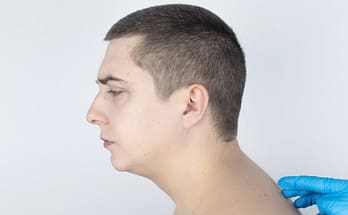Forward head posture is something we see all too often. People often slouch forward, whether they’re sitting at a desk or standing up. This can cause pain and discomfort in the neck and shoulders, as well as long-term problems.
Fortunately, there are exercises to fix forward head posture you can practice to improve your posture and alleviate these symptoms. Here are five exercises that can help you achieve better posture.
What is forward head posture and why we should care about it
Forward head posture (FHP) is a condition in which your head is positioned too far forward relative to your shoulders. This can put strains on the muscles and ligaments in your neck and shoulders, and over time, can lead to pain and discomfort. FHP is also a common contributing factor to headaches.
Thankfully, there are exercises you can do to help improve your posture and alleviate the pain associated with FHP. These exercises stretch and strengthen the muscles in your neck, shoulders, and upper back, which can help pull your head back into alignment. Practicing these exercises regularly can help you achieve better posture and find relief from neck pain, shoulder pain, and headaches.
– MedicalNewsToday
5 Exercises for Improving Forward Head Posture
1. Neck retraction
This exercise helps to stretch and strengthen the muscles in the back of your neck.
Instructions:
-Start by sitting up tall with your shoulders down and back.
-Gently tuck your chin, so that you feel a stretch in the back of your neck.
-Hold for 5 seconds, then release.
-Repeat 10 times.
2. Standing chest opener
This exercise helps to stretch the chest muscles and open up the front of the shoulders. This can help alleviate pain in the upper back and shoulders, and can also help improve posture.
Instructions:
-Stand with your feet shoulder-width apart and your arms at your sides.
-Clasp your hands behind your back and lift your arms up as high as you can.
-Hold for 5 seconds, then release.
-Repeat 10 times.
3. Doorway stretch
This is a great exercise for stretching the chest muscles and shoulders. It can also help to improve the range of motion in the shoulders.
Instructions:
-Stand in a doorway with your arms at 90-degree angles, elbows bent and palms flat against the doorframe.
-Lean forward until you feel a stretch in your chest and shoulders.
-Hold for 5 seconds, then release.
-Repeat 10 times.
4. Upper trapezius stretch
This exercise stretches the muscles in the upper back and shoulders. It can help to alleviate pain in these areas, and can also help improve posture.
Instructions:
-Sit up tall with your shoulders down and back.
-Tilt your head to the left
-Reach your left arm overhead and pull your head further into the tilt.
-Hold for 5 seconds, then release.
-Repeat on the other side.
5. Foam Rolling- Thoracic Spine
This exercise helps to loosen up the upper back area.
Instructions:
-Lie on your back with your hands behind your head
-Place the foam roller under your upper back.
-Start rolling slowly up and down starting from the middle of your back and working your way up to your shoulders.
-Keep your core tight.
-Repeat 10 times.
Practice these exercises regularly to see results
To see results, it is important to practice these exercises regularly. Aim for 3-4 times per week, and be sure to warm up before you start. As you begin to see improvements in your posture, you can increase the frequency and intensity of your workouts. Remember to listen to your body and stop if you feel any pain.
If you are consistent with your exercise routine, you should start to see improvements in your posture within a few weeks. With time and practice, these changes will become more permanent, and you will be able to achieve better posture and alleviate the pain associated with FHP.
Additional Tips for Improving Your Posture
In addition to practicing these exercises, there are other things you can do to improve your posture and alleviate the pain associated with FHP. These include:
-Wearing comfortable, supportive shoes
-Avoiding high heels
-Standing up tall and walking with good posture
-Sitting up straight in a chair with your feet flat on the floor
-Using an ergonomic office chair that supports the natural curve of your spine
-Avoiding slouching when you sit or stand
-Taking frequent breaks throughout the day to move your body and stretch your muscles
– Practicing mindfulness and paying attention to your posture
By following these tips and practicing the exercises regularly, you can improve your posture, alleviate pain, and find relief from FHP.
We hope that these exercises help you achieve better posture and alleviate any pain or discomfort you may be experiencing.
Remember that it takes time and practice to see results, so be patient and keep at it.
If you experience any pain or discomfort, be sure to stop and consult with a health professional.




